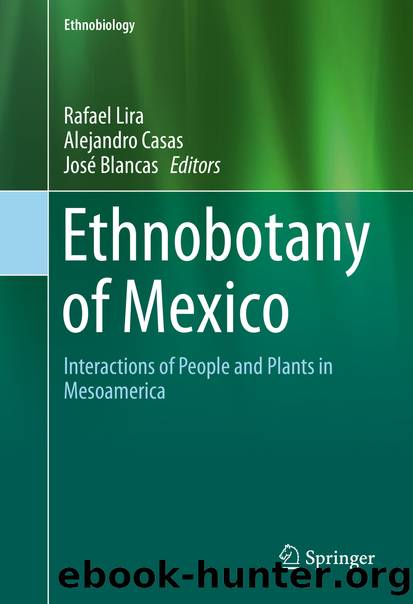Ethnobotany of Mexico by Rafael Lira Alejandro Casas & José Blancas

Author:Rafael Lira, Alejandro Casas & José Blancas
Language: eng
Format: epub
Publisher: Springer New York, New York, NY
Fig. 11.10Panorama of the morphological variation in some features significant for people managing Escontria chiotilla, Polaskia chichipe, and Stenocereus stellatus
One of the main questions is to whether the patterns of variation in these characters allow to identify patterns of morphological divergence among wild and cultivated populations and how divergent these are. We have analysed such question in several species. Figure 11.11 shows multivariate analyses of morphological characters among wild (W), silviculturally managed (M), and cultivated (C). Individuals closer among themselves are morphologically more similar and vice versa. The Fig. 11.11 illustrates that in Escontria chiotilla , the least intensely managed studied the wild and managed plants have relatively lower differentiation than wild and managed individuals of Stenocereus stellatus , which is also more intensely managed. It is possible to see that some wild and cultivated plants are similar among themselves. This is explainable because people continue introducing into cultivation wild plants in the managed systems, and also because in wild populations there is variation and part of such variation may include plants similar to those in cultivated areas. In fact, some of these plants are sources of material that is propagated in the managed systems. This information may be documented through interviews and corroborated through molecular markers [56].
Fig. 11.11Principal component analyses of the morphology of columnar cacti individuals from wild (s), in situ or silviculturally managed (m) and cultivated (c) populations. Each letter indicates one individual plant, its position in the plot depends on the general morphology (considering 15â23 morphological characters), individuals closer among themselves are more similar among themselves, and vice versa. Notice that the degree of differentiation of wild, silviculturally managed, and cultivated individuals is more pronounced in the species more intensely managed (Stenocereus stellatus)
Download
This site does not store any files on its server. We only index and link to content provided by other sites. Please contact the content providers to delete copyright contents if any and email us, we'll remove relevant links or contents immediately.
The Lonely City by Olivia Laing(4568)
Animal Frequency by Melissa Alvarez(4148)
All Creatures Great and Small by James Herriot(3986)
Walking by Henry David Thoreau(3681)
Exit West by Mohsin Hamid(3634)
Origin Story: A Big History of Everything by David Christian(3472)
COSMOS by Carl Sagan(3346)
How to Read Water: Clues and Patterns from Puddles to the Sea (Natural Navigation) by Tristan Gooley(3239)
Hedgerow by John Wright(3106)
How to Do Nothing by Jenny Odell(3101)
The Inner Life of Animals by Peter Wohlleben(3099)
How to Read Nature by Tristan Gooley(3077)
Project Animal Farm: An Accidental Journey into the Secret World of Farming and the Truth About Our Food by Sonia Faruqi(3018)
Origin Story by David Christian(2991)
Water by Ian Miller(2950)
A Forest Journey by John Perlin(2915)
The Plant Messiah by Carlos Magdalena(2745)
A Wilder Time by William E. Glassley(2689)
Forests: A Very Short Introduction by Jaboury Ghazoul(2671)
